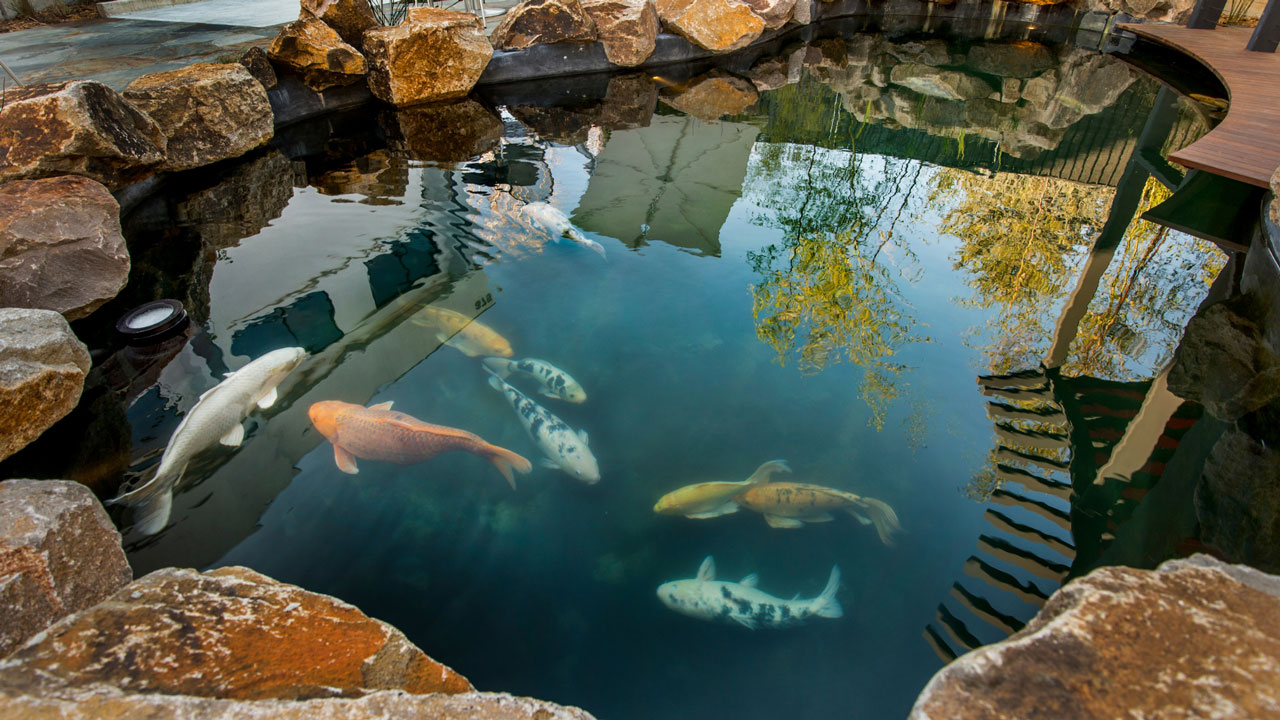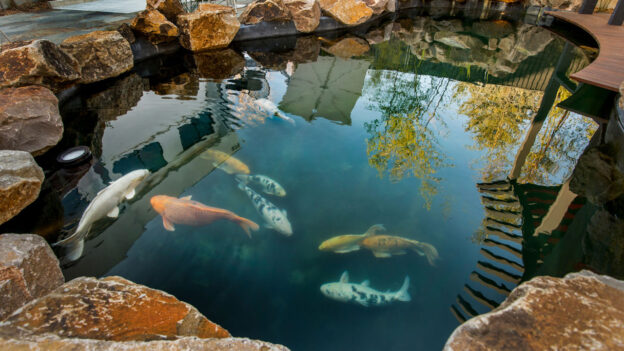
In this comprehensive guide, we will explore the principles of eco-friendly pond design, offering insights and tips for those looking to integrate sustainability into their backyard oasis.
Principles of Eco-Friendly Pond Design
Utilizing Natural Resources
- Rainwater Harvesting: Implementing a rainwater harvesting system for your pond can drastically reduce the need for tap water, conserving precious resources and reducing runoff. Collect rainwater from rooftops and direct it into your pond to maintain water levels naturally.
- Solar Power: Powering pumps and filtration systems with solar energy can minimize the environmental impact of your pond. Solar panels convert sunlight into electricity, offering a renewable energy source that can keep your pond’s ecosystem thriving.
Enhancing Biodiversity
- Native Plant Selection: Choosing native plants for your pond not only ensures lower maintenance but also supports local wildlife, including beneficial insects, amphibians, and birds. Aquatic plants are adapted to local conditions and can help establish a balanced ecosystem within your pond.
- Creating Habitats: Design your pond with various depths and include features like rocks, logs, and submerged vegetation to create habitats for different species. Shallow areas are essential for amphibians and insects, while deeper zones provide refuge for fish.
Sustainable Water Management
- Natural Filtration: Incorporating a biofilter, which uses natural processes to clean the water, can significantly reduce the need for chemical treatments. Plants and beneficial bacteria play a crucial role in breaking down toxins, ensuring clean water with less environmental impact.
- Aeration: Adequate oxygen levels are vital for a healthy pond ecosystem. Instead of relying solely on mechanical aerators, consider adding oxygenating plants and designing your pond to encourage natural water movement, such as gentle waterfalls or streams.
Tips For Designing an Eco-Friendly Pond
Creating a backyard pond is not only a beautiful addition to your outdoor space but also an opportunity to promote environmental sustainability. In this comprehensive guide, we’ll explore eco-friendly practices and sustainable design techniques for constructing and maintaining backyard ponds.
From selecting environmentally friendly materials to promoting biodiversity and conserving water, discover how you can create a sustainable sanctuary that benefits both your landscape and the planet.
1. Choosing Sustainable Materials
Explore options for eco-friendly pond construction materials, such as reclaimed wood, recycled plastics, and natural stone. Learn how to minimize environmental impact while maximizing durability and aesthetics in your pond design.
2. Water Conservation Strategies
Discover techniques for conserving water in your backyard pond, including rainwater harvesting, water recirculation systems, and native plant landscaping. Learn how to reduce water usage and promote sustainability while maintaining a healthy aquatic ecosystem.
3. Native Plant Selection
Explore the benefits of incorporating native plants into your pond design, including habitat creation, water filtration, and wildlife support. Learn how to select native aquatic and marginal plants that thrive in your region and promote ecological balance in your backyard pond.
4. Wildlife Habitat Enhancement
Discover how to create a thriving habitat for wildlife in and around your backyard pond. Explore strategies for providing food, shelter, and nesting sites for birds, insects, amphibians, and other native species, enhancing biodiversity and ecological resilience.
5. Natural Filtration Systems
Learn about natural filtration techniques for maintaining water quality in your backyard pond without the need for chemical treatments. Explore options such as wetland filtration, bog gardens, and floating islands that mimic natural aquatic ecosystems and promote ecological balance.
6. Energy-Efficient Equipment
Explore energy-efficient options for pond pumps, filters, and lighting systems that minimize energy consumption and reduce your ecological footprint. Learn how to select and maintain eco-friendly equipment that supports the sustainable operation of your backyard pond.
7. Integrated Pest Management
Discover eco-friendly strategies for managing pests and invasive species in and around your backyard pond. Learn about biological control methods, companion planting, and natural predators that help maintain ecological balance and minimize the need for chemical interventions.
8. Education and Outreach
Explore opportunities for education and outreach to promote eco-friendly pond practices in your community. Learn how to share your knowledge and enthusiasm for sustainable pond design with neighbors, schools, and local organizations, inspiring others to adopt environmentally friendly landscaping practices.
How Professionals Can Help You Build an Eco-Friendly Pond Design
Building an eco-friendly pond in your backyard isn’t just about digging a hole and filling it with water; it requires thoughtful planning and design to create a sustainable ecosystem that benefits both the environment and your enjoyment. This is where professionals come in. With their expertise, they can help you navigate the complexities of eco-friendly pond design, ensuring your pond is both beautiful and beneficial to the local ecosystem.
- Site Assessment: Professionals can conduct a thorough assessment of your property to identify the best location for your pond based on factors such as sunlight exposure, soil composition, and drainage patterns.
- Design Consultation: Experienced professionals can work with you to develop a customized pond design that meets your aesthetic preferences, functional needs, and sustainability goals. They can incorporate eco-friendly features such as rainwater harvesting systems, natural filtration methods, and native plant landscaping to enhance the ecological integrity of your pond.
- Sustainable Materials Selection: Professionals can recommend eco-friendly materials for pond construction, such as recycled plastic liners, reclaimed wood edging, and natural stone accents. They can also advise on the use of non-toxic sealants and adhesives to minimize environmental impact and promote water quality.
- Habitat Enhancement: Professionals can incorporate habitat enhancement features into your pond design to attract and support native wildlife, such as bird-friendly plants, amphibian habitat zones, and fish shelters. They can also create shoreline buffers and wetland margins to provide habitat diversity and promote biodiversity in your pond ecosystem.
Start Your Sustainable Pond Project Today!
Ready to create a beautiful and environmentally responsible pond in your backyard? Contact our team of professionals to begin planning and designing your eco-friendly backyard pond.
Let’s work together to bring your vision to life while promoting biodiversity, conserving resources, and fostering ecological resilience. Schedule a consultation today and take the first step towards enjoying a sustainable pond that benefits both you and the planet.
